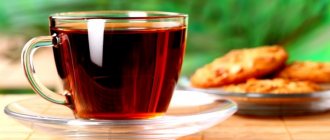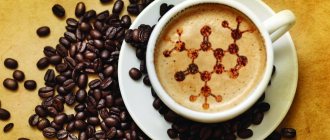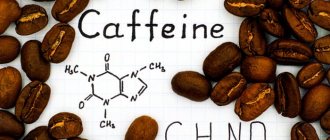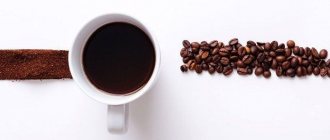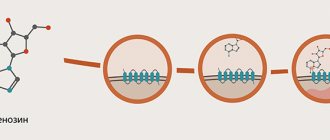Educational program: who are you and where are you from?
Many people imagine it as brown specks, similar to instant coffee. In fact, these are whitish or colorless crystals, bitter in taste and not at all impressive to a person far from science. We like its “presence” in Coca-Cola, green tea and other drinks primarily due to increased cardiac activity and stimulation of the nervous system. That is, simply put, it is the effect of caffeine that can awaken our consciousness and bring our brain out of morning hibernation.
Humanity has been familiar with this substance for quite a long time, and more specifically, since 1819, when Ferdinand Runge, a chemist from Germany, declassified its existence. Where do scientists get this substance? First of all, they can extract caffeine from waste coffee or tea (any, because caffeine is not only in green tea). It is also found in the fruits of a plant called coca (yes, it became the basis of the popular drink Coca-Cola). And, besides - just don’t fall - for industrial needs it is synthesized from uric acid. This is how caffeine is produced in tablets.
And, by the way, caffeine is still considered a drug - the same as cocaine (even the names are similar).
Of course, it is not as harmful as drugs that are officially prohibited by the police - but it can be highly addictive. Your body can no longer live without a morning cup of coffee? You see, you are already “in the system”.
Drinks containing caffeine
The alkaloid content in drinks can vary: both small and large. Based on the recommendations for its consumption, it is worth excluding or including some of them from the diet. Among the drinks with high content are:
- Cocoa-based drinks;
- Usual tea and coffee;
- Carbonated and energy drinks;
- Some types of non-alcoholic beer;
- Chicory, etc.
Coffee
A small 85 ml cup contains about 55 mg of caffeine. Noteworthy: even so-called decaffeinated coffee contains this alkaloid! Two or three cups can be equal to one ordinary mug of a traditional drink - coffee.
Tea
The content of the substance of interest to us in such a familiar drink as tea varies depending on the method of brewing and processing of the leaves. For example, long fermentation will eventually yield black tea. The level of alkaloid in it is about 65-60 mg per ordinary dessert cup.
In the case of green tea, the picture changes significantly: the average cup contains no more than 45 mg of the substance. Based on this, it is not difficult to conclude: black tea will help you cheer up and feel fresher.
Caffeine content in cocoa
Does cocoa contain caffeine? No matter how strange it may be - yes! Its mass fraction in the drink is about 200 mg per 100 g of dry powder. However, a simple serving cup provides an average of 10 mg.
Chicory
Chicory is a well-known flower that grows in Russia. And also – the same name brand of a drink loved by a large number of people! Caffeine in chicory is contained in its natural form, or rather, in the form of an analogue: intibin glycoside. It is this substance, due to its absolute naturalness, that makes chicory absolutely harmless. For both old people and children!
Contents in Coca-Cola
Anyone who loves carbonated drinks, in particular Coca-Cola, is probably familiar with its invigorating effect on the body. Some people mistakenly believe that soda contains horse doses of the alkaloid, however, they are mistaken in this: for a fairly large 330 ml portion of cola there is only 34.5 mg.
But in its main competitor, the Pepsi drink, the dose of caffeine is higher for the same volume. It is 37.5 mg.
In energy drinks
It's no secret that energy drinks contain huge amounts of caffeine. Energy drinks that contain guran or its extracts are especially rich in it. The dose of the substance in this type of drink is comparable to the dose contained in a cup of strong coffee: 115 mg per 170 ml.
Is there a lot of it in drinks?
How much caffeine is in a cup of coffee? What about Pepsi or Coca-Cola, and how much of this “whitish-bitter” substance is in green tea? We answer one by one!
- When you drink your morning coffee, you absorb between 90 and 200 mg of caffeine (the highest level in drinks). By the way, if the packaging of your coffee says that it does not contain caffeine, this is not true, in fact it does exist, just in microdoses (from 8.6 to 13.9 mg). In general, completely decaffeinated coffee products are a myth. True, you can drink this coffee twice as often - you will not be in danger of overdosing.
- Tea contains a minimum of 30 and a maximum of 70 mg of this substance.
- In fizzy sodas like Coca-Cola it is even less - from 30 to 45 mg of caffeine.
Does cocoa have caffeine? Yes, ubiquitous scientists (and not British, but from different countries) claim that it is also contained in cocoa fruits, so all products made from these fruits are not in vain for raising our blood pressure and mood, that is, they have a very characteristic influence on our body.
Caffeine in tea, coffee, cocoa, energy drinks
Tea
Caffeine in tea is represented by its natural analogue tannin, which has a milder effect on the nervous system, while maintaining a stimulating effect. Therefore, if you give up coffee, you can switch to tea, which reduces the likelihood of complications from the nervous, digestive and cardiovascular systems. The level of caffeine in tea is quite difficult to determine, since this indicator is influenced by the following factors:
- Quality of brewing - the upper shoots of the tea plant contain significantly more active substance than the lower shoots.
- Leaf fermentation – processing over a long period of time has a destructive effect on caffeine, which is why caffeine levels in black tea are significantly lower than in green tea.
- Method of preparing the drink.
- The quality of the tea mixture, the presence of impurities in it.
- Areas where the tea bush grows, climatic features.
Green tea contains about 50 mg of caffeine per 100 ml of drink, while black tea of the same volume contains about 45 mg of the alkaloid. Caffeine is contained in a lower concentration in the Pu-erh tea variety - from 5 to 10 mg in one 100 ml cup, but hibiscus tea does not contain any active substance, therefore it is absolutely harmless.
Cocoa
Cocoa, a childhood favorite drink, also contains a small concentration of caffeine, namely about 8 mg per serving, which is about 15 times less than coffee and 6 times less than one cup of tea.
Cocoa is also included in chocolate - one bar contains about 80 mg of caffeine. At the same time, milk chocolate contains 1.5-6 times less caffeine than black chocolate.
Chicory
The most popular coffee substitute that has tonic properties. Not only people trying to give up caffeine, but also adherents of a healthy lifestyle, replace coffee with a drink made from chicory. In addition to having a similar effect, chicory is similar to coffee in taste. Despite its stimulating effect, chicory does not contain caffeine, so it does not excite the nervous system, but helps to balance it.
Coca Cola
The composition of the drink Coca-Cola and its analogue Pepsi contains about 30 mg of caffeine per glass. Thanks to this, carbonated drinks have a stimulating effect on the nervous system, eliminating drowsiness. You can get an additional boost of energy in such cocktails thanks to the large amount of sugar in the composition.
Abuse of Cola and Pepsi causes many side effects and worsens health. Drinks become especially dangerous for children whose bodies are in the process of formation.
Energy
Energy drinks are positioned on the market as drinks that give a boost of vivacity and energy. However, this is only a publicity stunt, since the person who consumes energy drinks does not receive energy. Caffeine stimulates the use of internal resources. Therefore, excessive drinking leads to rapid exhaustion of the nervous system and overload of the heart muscle and blood vessels.
The energy effect is achieved due to the inclusion of caffeine as the main component, and due to the enrichment of the drink with gas, the absorption rate is accelerated up to 3 times, so the effect of the energy drink can be noticed 10 minutes after consumption. The amount of caffeine in one 300 ml serving varies from 60 to 150 mg.
Diet pills - myth or reality?
It is believed that the drug “Caffeine-sodium benzoate” will help any beauty of size XXL to become a doe. In addition, this tableted caffeine is very popular in bodybuilding - it supposedly quickly burns fat, revealing painstakingly built muscles. Is it so? It is known that this substance causes our body to produce fatty acids, and quite a large amount of them. "Profit": for
During one workout, you “eat” more of the extra grams accumulated in the body in the form of fat. That is, if you don’t sit on the couch, but work in the gym, “Caffeine Benzoate” really works. True, official medicine does not quite like this weight loss instruction. Many people are at risk of a banal overdose while taking the drug “Caffeine Benzoate”: with an average weight of 100 kg, they swallow about 300 mg of caffeine (and this is our daily norm), plus don’t forget about tea, Coca-Cola, coffee (even decaf) ... Such weight loss only results in harm to the body. So it’s better to replace “Caffeine Benzoate” with something simpler – tea before a workout, for example. After all, there are products that also have a high caffeine content, but the harm from them is minimal.
How much cola can you drink a day?
Average soda consumption in the United States has doubled over the past thirty years, peaking at 500 ml per person per day in the late nineties(4). Moreover, in some states the average person drank more than one liter of cola per day. At the same time, we are talking about the average figure - if you do not take into account people who do not drink soda at all, the figure will be significantly higher.
We can say with 100% confidence that daily consumption of cola in such quantities has a negative impact on health - from the destruction of tooth enamel and stomach problems to the development of obesity. Naturally, nutritionists do not give recommendations on how much cola you can drink per day, but recommend completely eliminating any type of soda from your diet.
Is Coca-Cola an evil company?
Naturally, companies such as Coca-Cola or PepsiCo do not have a stated goal in their charter to deliberately spoil people’s health and provoke mass obesity. The high sugar and caffeine content in drinks is due solely to the fact that this is the taste that people like most and this is the product they want to buy. In the end, it all comes down to maximizing profits.
Unfortunately, the main goal of these companies is based on creating loyal consumers (so-called “heavy users”) - those who drink more than two cans of cola a day. More than 80% of all soda sales come from them(3). It is also important that the formation of the habit of constantly drinking cola begins in childhood - and that is why it is better not to give it to children at all.
Sports drinks and isotonics - a new market
To boost sales, Coca-Cola partnered with McDonald's in the 1980s, making the combination of cola and fast food an industry standard. This was followed by an emphasis on small neighborhood stores - in the USA they were often bought out only in order to compete with competitor brands (2). The main priority in recent years has been sweet juice, bottled sugar tea and sports drinks.
Unlimited advertising budgets are spent on promoting the fact that athletes definitely need isotonic drinks Powerade or Gatorade - products of the same Coca-Cola Company and PepsiCo. Despite the fact that sports doctors and nutritionists constantly remind that the only difference between Powerade and cola is the taste and lack of gas, simply no one listens to them.
***
The secret to the success of cola is a composition that does not remove thirst at all, but only provokes it, forcing you to drink more. The question of whether the composition contains sugar or a sweetener plays a secondary role - ultimately, drinking any soda is incompatible with weight loss, since it almost always provokes a person to consume excess carbohydrates.
Scientific sources:
- Caffeine Chart - Center for Science in the Public Interest, source
- How The Food Industry Manipulates Taste Buds, source
- Industry Studies, Edited by Larry L. Duetsch, source
- Effects of Soft Drink Consumption on Nutrition and Health, source
The date of last update of the material is May 7, 2019
Wraps: caffeine plus Capsicum
A caffeine wrap is not for delicate young ladies, as it takes time and also stings the skin. It is considered “hot” - harmless, but quite intense; The effect is quick, but the cost is cheap.
Composition of the wrap with caffeine ampoules:
- 4 ampoules of caffeine;
- a tiny pea of Capsicam ointment;
- a few spoons of liquid baby cream.
Here's how to use a caffeine wrap:
- Don't eat for 40 minutes (this is a very important instruction).
- Mix all ingredients.
- Apply a small amount of product to the “orange peel” areas – arms, tummy, thighs.
- Wrap yourself in cling film and put on something warm on top.
- Wait 30 minutes to 3 hours. It will burn, or, in extreme cases, warm.
- Rinse everything off with warm (another important instruction - not hot) water.
- Soothe your skin with a nourishing cream and fast for another two hours.
It is better to do such wraps once every two days (more often it is not worth it - there will be an “overdose”, that is, harm to the body). Course – 10 procedures. Wraps will help remove “bad” water from the skin, the result of each “steam room” will be visible on the second day.
Benefits of Coca-Cola
The only benefit that Coca-Cola brings to the body is the ability to very quickly cheer up and improve tone. This effect occurs due to caffeine. Normally, this substance stimulates brain function, trains memory, increases performance, and helps withstand heavy mental stress. If we talk specifically about cola, then the caffeine in it, thanks to the action of additional components, improves mood and helps fight depression. But this effect is short-lived. By resorting to such an artificial way to cheer up, you can get used to drinking the drink.
Many will be surprised, but some doctors recommend Coca-Cola as a cleanser. Previously, such advice was given only to American patients, but increasingly in our country such methods are also used. It should be noted that soda is consumed in minimal quantities.
This is interesting! It has long been known that with the help of Cola, old stains on clothes are removed, scale is removed, and even toilets are cleaned. But few people know that every American policeman always has at least two large bottles of Coke in his car. Only the drink is not there to quench your thirst, but to cleanse the roads of blood after an accident.
When will a doctor recommend caffeine?
The active effect on the body has made this substance practically a medicine. Caffeine can be found in tablets such as Novomigren, Citramon, Asfen, Pyramein or Novocephalgin. Their instructions are convincing: the drugs are indicated for hypotension, fatigue or exhaustion, cardiovascular collapse, and even infectious diseases. In combination with other drugs, this remedy helps against cardiac decompensation. Finally, this is the best salvation for the body suffering from a hangover.
Caffeine is harmful to children under 6 months, and since its effect on the nervous system is quite strong, it is also prescribed to older children with caution. The daily intake of caffeine for adults is 1.0 g (you can swallow no more than 0.3 g at a time - the medicine in a higher dose causes harm, not benefit). For children, you should not take more than 0.025 g at a time (child up to one year). The side effects of these medications are considered to be a strong heartbeat and insomnia. And, by the way, there are also contraindications: caffeine is harmful for insomnia, high blood pressure, glaucoma, atherosclerosis, and also at a very advanced age. In all these cases, “taking the drug” is possible only in tea – and even then not strong.
Poisonous drugs in the history of medicine
Pharmacology, like medicine, is the same age as humanity. Some medications, despite very advanced age, have proven their benefits and are still sold today. Others were abandoned when it turned out that their action was a figment of fantasy or a coincidence. Drugs that had a beneficial effect became history when analogues appeared that were more effective and cheaper.
But completely apart are substances that seemed like medicines, but turned out to be actually poisons.
In fact, almost everything you can buy at the pharmacy (including over-the-counter drugs) is fraught with potential danger. No one has denied the truth of the saying “there is medicine in a spoon, but poison in a cup” (i.e., harm from an overdose), nor the existence of side effects for any pill. However, for the “medicines” that will be discussed below, the therapeutic effect (if there was one at all) should be considered a side effect. The main thing was truly disastrous.
Morphine, heroin and other cough medicines
From the “narcotic” list, only morphine is used in medicine to this day - for example, as a powerful pain reliever for myocardial infarction. However, he is strictly accountable. Knowing this, it’s hard to believe that it was only in 1911 that a sedative syrup containing a hefty dose of morphine was condemned as a “child killer” in Great Britain.
conclusions
In general, caffeine content is everywhere - even in good old Citramon. If you “take on your chest” only the amount that is in tea or Coca-Cola, the effect on your nerves will be insignificant: you will quickly wake up and get to work with great energy. However, in higher doses, caffeine can also cause harm. But don't worry! The lethal dose for an able-bodied adult is 70 cups per day. Even the most inveterate coffee lover won’t drink that much!
We hope that this article was useful to you, we will be grateful if you share it with your friends on social media. networks. Have a nice day and see you again!
How Coca-Cola is killing us
Representatives of the New Vatican on Capitol Hill have firmly planted their tentacles in our homeland. They hooked our people on harmful Coca-Cola. Composition of the drink
What is Coca-Cola made from?
Sparkling water. Sugar. Natural caramel dye. Natural flavors. Phosphoric acid is an acidity regulator. Caffeine. Natural spices that are a trade secret (Coca leaves, from which Cocaine is made).
Nobody knows the final recipe of this food product, because it is almost the intellectual property of this company, although one rule always applies to food products - there must be a 100% open recipe, emphasized the former head of Rospotrebnadzor, assistant to the Prime Minister Gennady Onishchenko
Harm of cola:
Constant consumption of cola provokes tooth decay. Phosphoric acid removes calcium from the body, weakening bone tissue. Although the composition does not now include cocaine, the drink is still addictive. It is not recommended for pregnant women to drink cola, as a number of substances included in the composition can have a negative effect on the fetus. Cola causes obesity.
If you drink a glass of cola:
The body will instantly receive 9 tablespoons of sugar. A person does not feel sick only because cola contains phosphoric acids, which have the property of preventing vomiting. The pancreas releases large amounts of insulin into the body to convert compound sugars into fats. After about forty minutes, the body will finish absorbing caffeine, it begins to have a stimulating effect: blood pressure rises, pupils dilate, and some receptors are blocked. Then the hormone dopamine irritates the pleasure center of the brain and the person experiences pleasant emotions. The drink has a diuretic effect and calcium, sodium, zinc, magnesium, and electrolytes are removed from the body along with urine. After an hour, the person already experiences lethargy and irritability.
Our food culture does not need this kind of drinks; we have our own good palette of both all-Russian and regional drinks based on both fruits and herbs
The best drink is water! If you really want to, make your own lemonade by adding lemon and mint.
In April 2019, a group of scientists from Harvard (a stable top-3 ranking of the best universities in the world) published a large-scale study, for which they followed more than 80 thousand women and 37 thousand men for 34 years (from 1980 to 2014). The results showed that the more sugary drinks - such as cola - a person drank, the higher the risk of premature death from any cause.
Specific numbers:
– from one to four drinks per month – the risk of mortality increases by 1%;
– one or two drinks a day – by 14%;
– more than two drinks a day – 21%.
